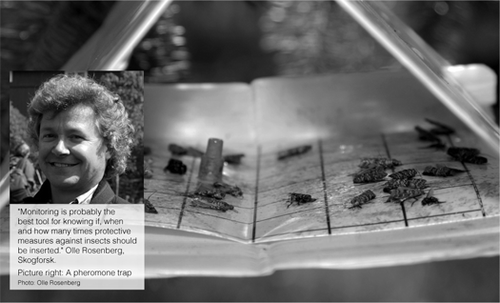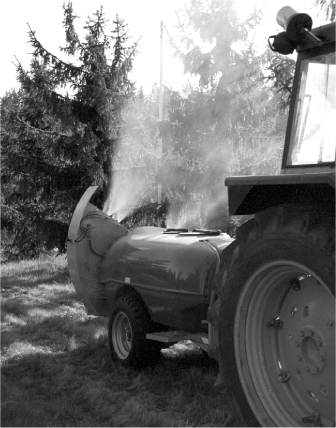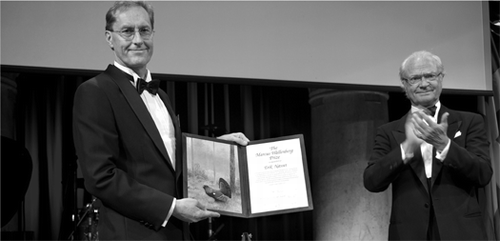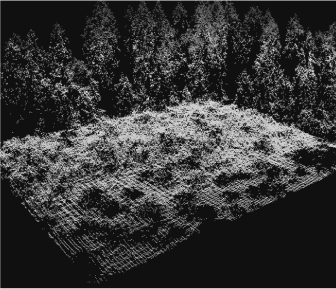Valuable seed destroyed by insects

Damage by cone and seed insects is a severe impediment to those producing conifer seeds in seed orchards. The SNS-supported network "Nordic cone and seed insects" has been cooperating to address this problem since 2007. One of the outcomes is the coordinated monitoring of the most important insect species. The data collected form a basis for establishing strategies for pest management.
Seeds from seed orchards are the most valuable product per unit volume in forestry. Spruce seeds from seed orchards not only have a high market value (_1 000–1 500/kg), but trees derived from these seeds ensure higher growth rates and better wood quality. Insect damage has been reported to cause over 90% loss of the expected seed yield from orchards in the Nordic countries. A review of Swedish cone sampling protocols between 1983 and 2004 showed an average infestation rate of 40%.
The problem with seed- and coneeating insects is common to all Nordic and Baltic countries. In Denmark, the economic losses are highest in seed orchards of bies species, while Norway spruce suffers the most severe problems in Norway, Sweden, Finland and the Baltic states.
The Nordic Cone and Seed Insects network has been active since 2007. It draws together expertise in the area to discuss experiences and to find management options that will help to prevent more seed from being destroyed. Coordination of the network has circulated among the members. Currently, Dr Olle Rosenberg of the Forestry Research Institute, Sweden (Skogforsk) is in charge. He is optimistic about the chance of finding management solutions. But he is also pragmatic about all the questions that remain to be answered.
– With joint efforts, we now have a much better knowledge of the most important pests, and we also have a good range of experience of some of the measures that can be adopted to combat them, he says. One of the major cone insects is the spruce cone worm, Dioryctria abietella. This species was the focus when the network was established. A common protocol for monitoring the species in seed orchards was set up, and has resulted in a mass of data about when and where the insect appears.
Monitoring with pheromone traps
Monitoring of the spruce cone worm has been going on, more or less without interruption, since 2007 in Denmark, Sweden, Finland and Norway, and since 2009 in Estonia.
– The flight period is relatively long, from late May to late August, although some individuals have been captured in late September. The start of the flight period is very dependent on temperature. The information we gain might in the future help us to predict when protective measures are necessary, says Olle Rosenberg.
A prerequisite for successful monitoring was the availability of a synthetic pheromone, specific to the spruce cone worm. The pheromone was developed by researchers at the University of Lund in collaboration with Skogforsk, INRA in France and the University of California. The pheromones attract adult males of the moth to the trap.
While Dioryctria abietella was the first species to be studied, the network has gone on to study the spruce seed worm, Cydia strobilella. A pheromone for this species was developed in a cooperative project involving Skogforsk and the University of Lund. Coordinated monitoring of Cydia strobilella is currently going on in Sweden, Finland and Estonia.
Biological treatment
For over a decade, Skogforsk has been testing and developing a biological treatment using Bacillus thuringiensis var kurstaki/aizawai (Btk). The bacteria produce poisonous substances which kill the moths in the cones. The results have so far been successful, with a reduction in the number of damaged cones to a third, all at a reasonable cost.
Other treatments involve chemical insecticides, which are used on a trial basis. The ongoing struggle to reduce pesticides in the EU calls for integrated pest management strategies. Monitoring is thus a help to avoid unnecessary pesticide applications.
Results from the Nordic cone and seed insect network have been reported at various international conferences. The intention now is to assemble the experiences into a review paper on cone and seed insects and to produce another paper about the monitoring conducted in the Nordic countries.
Contacts:
Olle Rosenberg, Skogforsk, Sweden
Tiina Ylioja, Metla, Finland
Hans Peter Ravn, University of Copenhagen, Denmark
(hpr@life. ku.dk)
Paal Krokene, Norsk Institutt for skog og landskap, Norway
Kaljo Voolma, Estonian University of Life Sciences, Estonia
Don't miss the jubilee conference
SNS was established in 1972 and, since then, has been the hub for forest research cooperation in the Nordic and Baltic countries. In 2012, the organisation will, therefore, have supported and initiated research networking for 40 years. The jubilee will be celebrated with a conference from July 3-4 2012 at the University of Copenhagen, Denmark.
The theme of the conference is "New challenges for sustainable forestry". The conference will focus on Nordic forest research, position SNS in the European and global network, and direct scientific and political attention towards the research areas.
More information, the programme and registration details will follow on the SNS webpage
Nominate Cultura Prize winner
The Alfred Toepfer Stiftung invites nominations for the Cultura Prize. The 2012 prize will emphasize scientific achievements in forest science. Nominations must be submitted by December 20, 2011 to [email protected].
The cash prize is worth _25.000.
Apply for BONUS projects
Check out for the call from the Eufunded BONUS programme, which focus on research for the Baltic Sea region. The call opened on 1 December, and some themes may be relevant for forest researchers, such as "Changes in catchment land cover patterns".
Read more: www.bonusportal.org
Spreading of Btk in a seed orchard
Photo: Olle Rosenberg
New seed pest insect
One of the most serious pest insects in seed orchards in North America, Leptoglossus occidentalis, has been found in Denmark, Norway and Sweden. It is probably just a matter of time before the species can be found in our orchards.

New website disseminates Nordic and Baltic forest research
The new website NB Forest was launched in December 2011. The site strives to act as a regional information and communication portal for forest research in the Nordic and Baltic countries.
NB Forest will provide news, facts and research results from the Baltic Sea region. The website has been produced jointly by SNS and EFINORD in order to build a bridge between national research communication and the global research arena.
– Many research fields are so specific that collaboration across borders is necessary, NB Forest will offer a platform for sharing knowledge and experiences between countries. says Pernille Karlog, chair of SNS.
The communication portal does not replace the website of SNS, but adds a new dimension. While SNS publishes updates on ongoing networks and projects, NB Forest will be a place for sharing experiences in a wider context.
The portal will initially be used by those participating in projects supported by SNS and EFINORD. However, it is also open to other research organisations who want to disseminate their results to a broader international audience.
– By displaying results in English, we also offer a window for smaller institutions to show their activities to researchers and decision-makers in the whole region, and also in Europe, says Mika Mustonen, head of the office at EFINORD.
Currently NB Forest supports the following types of information: news, facts and reviews, a blog and events. Fact sheets give brief presentations about the forests, forest industry and research within each country.
– The portal is only a first step. Now we can start to consolidate NB Forest as a regional channel for forest research information, says Mika Mustonen.
The portal is one of several activities where SNS and EFINORD are cooperating in order to strengthen research networking in the Nordic and Baltic region.
– It is very exciting that we are able to communicate research findings to a much larger audience. All SNSfunded networks, projects and Centres of Advanced Research (CAR) can now share their results with colleagues in the whole Baltic Sea Region, says Katrine Hahn Kristensen, secretary of SNS.
Check out the webpage:

Airborne laser scanning research acknowledgedwith the 28th Marcus Wallenberg Prize
During a ceremony in Stockholm on 3 October, the Marcus Wallenberg Prize 2011 was awarded to Professor Erik Næsset. He received 2 million Swedish Crowns.
The prize was awarded "for hisground breaking research that incorporates the airborne laser scanning method as an integral part of forest inventory".
His scientific work demonstrates prudently the progression of a research idea to implementation and how to make a scientifically developed method fully operational in practical forestry globally."
Professor Næsset was previously a member of the Scandinavian Journal of Forest Research editorial board, and was also the winner of the journal′s Jubilee Award, presented in 2010 to the most cited author.
An interview with Erik Næsset about laser scanning inventory in the Nordic countries can be found in News & Views No. 6, 2010.
Right: Picture of a forest made with laser scanning. Courtesy: Terje Gobakken and Svein Sohlberg, Norwegian University of Life Sciences.
Picture above: Prof. Erik Næsset, Norwegian University of Life Sciences receives the 2011 Marcus Wallenberg
Prize from H.M. King Carl XVI Gustaf, on 3 October 2011.
Photo: Janne Eriksson. Ref: www.mwp.org
